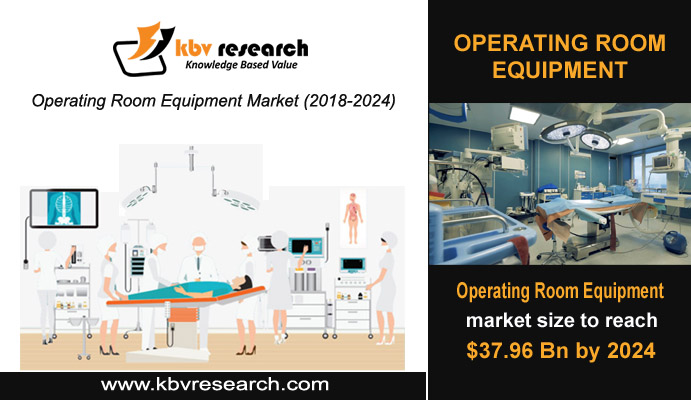
Operating room is the most commonly used facility for performing surgical procedures. The facility is used for treating various physiological and pathological conditions in a highly spotlessly clean environment. Operating rooms in this day and age are fully maintained with technologically advanced equipment that helps surgeons by offering greater flexibility and comfort while conducting surgical procedures, and ensure efficient, error-free operations.
According to a recent report by KBV Research, one of the leading market research companies, the worldwide market for Operating Room Equipment is anticipated to reach $37.96 Billion by 2024, rising at a CAGR of 6.2% over the forecast period.
Prominent benefits including minimal trauma, lessened hospital stays, and cost-friendly procedures are contributing factors in the growing popularity of minimally invasive procedures. These factors are pushing the development of operating room equipment market. Augmented investments by government bodies all across the globe are pushing the growth of this market.
The increasing number of ambulatory centers and rising product innovations are the most prominent factors that are stimulating the evolution of the market for operating room equipment. Furthermore, the escalating count of surgical procedures performed across the globe along with the rising aging population are mounting the development of the market. Chronic diseases rate is increasing, which is emphasizing on the need for advanced operating room equipment.
Certain essential operating room equipment are required by OR professionals on a per case basis. Each section of equipment serves a specific purpose and makes it convenient for the personnel to get their job done. The history of operating room equipment is extensive, and diverges depending on the part of equipment. Fine-quality surgical lighting is vital in conducting intricate procedures in the operating room. Surgical lights are designed to provide bright white light for illuminating the surgical site and removing shadows.
Anesthesia Devices
Anesthesiologists routinely use technology and medical devices to carry out their daily activities. Anesthesia devices have recently witnessed advances in medical technology. These advances have enlarged the number and amplified the quality of medical devices available in operating rooms. Evidently, the emerging tools have enhanced the adoption of anesthetic devices in an operating room. Newer devices and advancements in older devices have reformed the manner in which anesthesia devices are administered. Emerging fiberoptic technology and developments in computational processing, and in physiologic monitoring have increased the adoption of anesthesia devices in operating rooms and made the practice of anesthesiology more efficient.
Operating tables are usually used in an operating room or surgical suite of a hospital, ambulatory surgery center, or various other healthcare facilities where surgeries are conducted. Operating tables are either stationary or mobile to be moved from room to room. Operating tables are adopted in various procedures like cardiothoracic, bariatric, robotic, orthopedic, urologic, and other medical operations.
Click Here For Free Insights: https://www.kbvresearch.com/news/operating-room-equipment-market-size/
The emergence of cutting-edge diagnostic and imaging technology for the Operating Room is somehow making the rooms congested and complex with a assembly of OR devices and monitors. Operating room integration system is being designed to streamline room by combining data, providing access to video, and controls for all of the devices at a central command station. This is enabling the surgical staff to perform their tasks efficiently without having the need to move around the OR. The operating room environment requires focus, efficiency, and expertise. With incorporation of OR integration, surgical teams can navigate around the room and perform a variety of tasks. Hospitals are initiating investments in new devices and digital technologies that are promising a new era of innovation for surgery. They indicate towards a future where more patients can opt for minimally invasive outpatient surgeries and faster recoveries, with fewer complications, less pain and scarring.
Technology is driving remarkable changes in healthcare and acquisition of knowledge, in information and their distribution is multiplying exponentially. Robotic replication in medical treatment provides a safe environment for students and doctors working in an operating room.